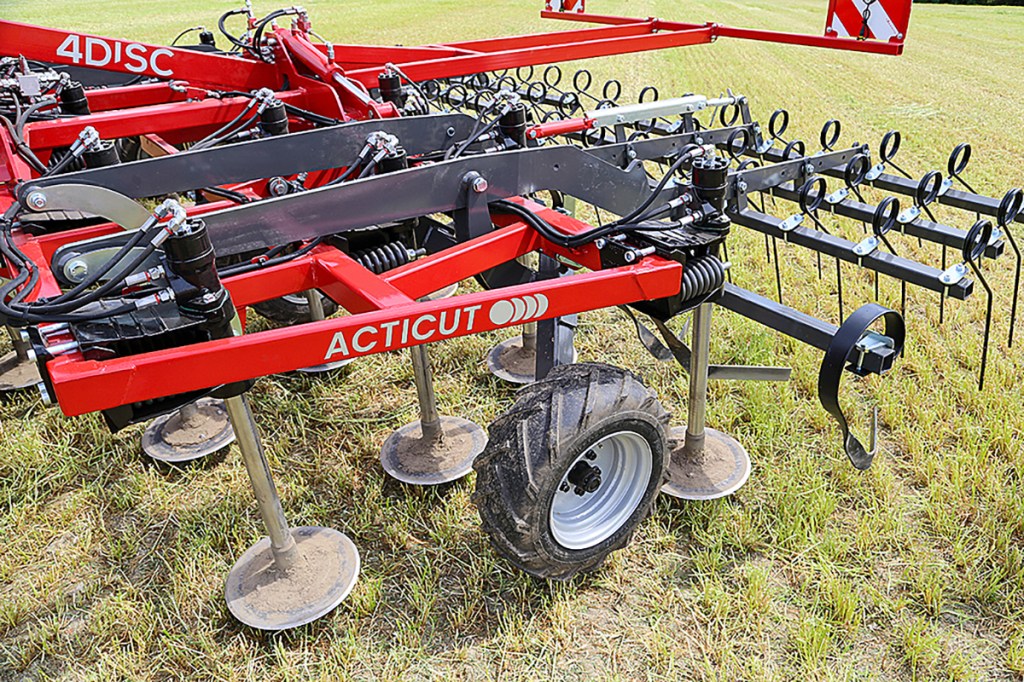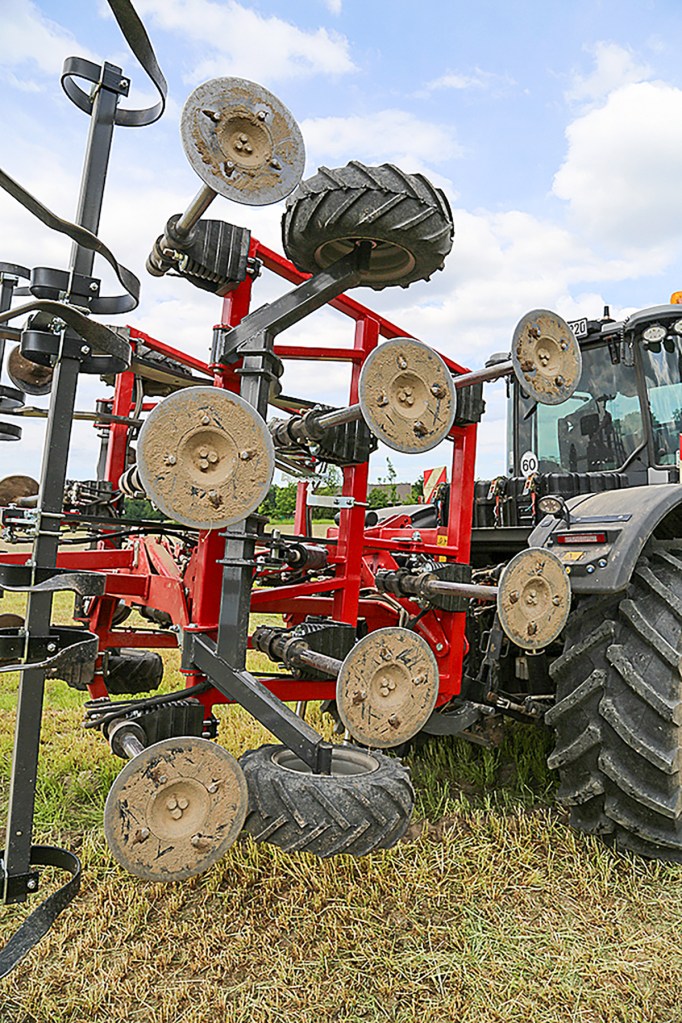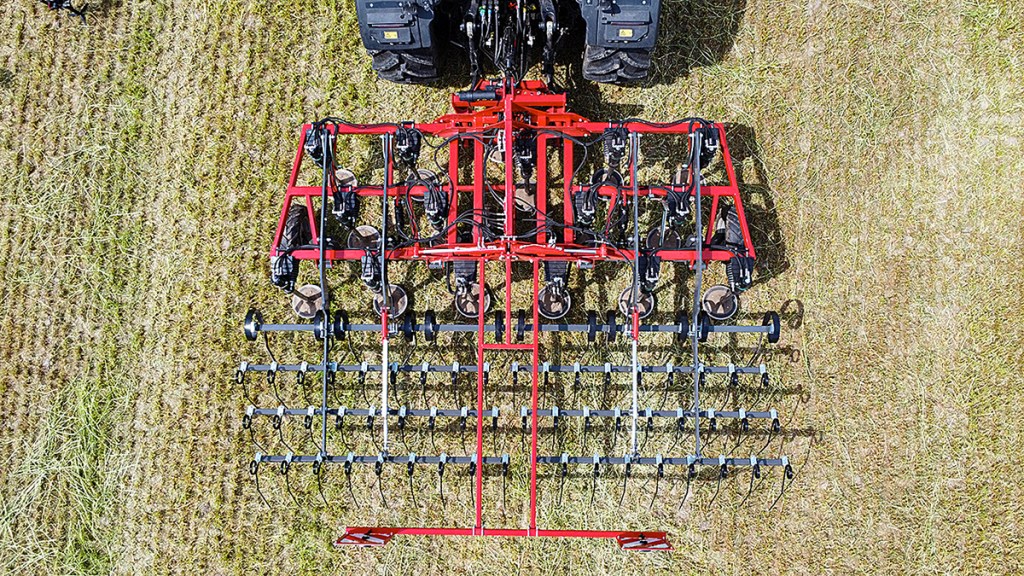It’s not often that a slightly different tack is taken to cultivations, but the Acticut does just that, with horizontally powered discs used to cut below the surface for a shallow tilth. We had a chance to get a closer look at the German-made machine from 4Disc.
KEEPING IT BRIEF
- The discs that till the full working width are hydraulically powered.
- All of the discs are arranged symmetrically and rotate in opposite directions.
- Penetration always appeared effective, even in hard, dry soils.
At the last Agritechnica show, 4Disc presented the ActiCut — an ultra- shallow cultivator with a difference. We took a closer look at the novel design that utilises horizontally powered rotating discs, which aim to move all the soil at an ultra-shallow depth while also slicing through plant roots. The model shown here is the ActiCut 450, which we tucked into a field of grass stubble.
Lightweight construction
There are various models of the ActiCut, all of which mount to Cat. III lift arms. All are deliberately designed to be light in weight, with the 4.50m model weighing in at just under 2.5t.
This lightweight design is possible thanks the Dynamic Traction Control (DTC) system that shifts tractor weight onto the cultivator by pressing against the underside of the tractor’s lower links, thereby transferring around 600kg of additional weight to the cultivator when needed.
Four spool valves are required: three double- acting units (for the wings, the depth and the harrowing tines) and one single-acting valve with free return line for the motors that drive the discs.

The discs are clamped to the frame with the help of a patented bracket. Coil springs protect the discs from being overloaded, enabling them to move both backwards and sideways to overcome any stones and other such nasties. The tripping force is said by the maker to be 270daN.
A hydraulic motor is located above each unit, driving a 50mm shaft which, in turn, powers the disc. The shafts are mounted at a slight angle so that the discs sit at an angle of about 5° relative to the ground. This pitch and the rotating action are reckoned to result in effective penetration no matter what the ground conditions.
Symmetrical layout
Disc diameter is 35cm, and the line spacing is 28cm. This ensures a sufficient coverage and a full-width cut. All tools are arranged symmetrically in the frame.

Hardened disc edges are designed to stop excessive wear, and the single-sided bevel ensures the cutting edge is self-sharpening. Swapping a disc is easily done by loosening four screws.
Although the hydraulic motors are supplied by the same spool and oil line, they spin in different directions. Disc speed is adjustable from 60 to 80rpm. The cut can be extremely shallow, ranging from 1cm to 12cm, but a full working width is still achieved from one side to the other.
Depth control comes from the four gauge wheels (two wheels guiding each wing) and the tractor linkage. The two depth control rams are connected so that they control all four wheels in synch for maximum precision.
The folding rams are supplied with pressure from the hydraulic circuit that feeds the discs. This design translates into effective ground following and good contouring. The system is always enabled; there is no need for the operator to enable it separately.

Tines make up the rear
The so-called LevelCheck system connects the frame that carries the gauge wheels with the suspension system for the harrow tines, so that the harrow is always set to the correct depth. There was a total of three rows of following tines on our machine, with a spacing of 9.3cm between the 12mm thick tines.
The aggressiveness of the harrow can be adjusted hydraulically, and the last row can be altered separately on a crank.
Mounted between the harrow and the disc sections are the row of hockey stick style levelling tines.
In-field performance
We tucked the ActiCut into a field of freshly harvested grass silage stubble. Sown the previous harvest, the stubble height was about 8cm. We cultivated the sandy loam at a depth of 2cm, and, although it was dry, penetration was not an issue. We operated the discs at around 80rpm.

The Fastrac 4220 with nearly 220hp was more than up to the job, purring along at a forward speed of 12-16km/hr. The discs actually delivered a remarkable amount of intensive mixing. The harrows then combed out the roots and left them on the surface to dry.
For a test comparison, we worked the other half of the field with a traditional low-disturbance cultivator. Both plots were then worked once more at topsoil depth before being given a tickle with a power harrow prior to sowing with maize. Between the two plots, there were no visible differences in emergence and growth.
As of yet there is no UK distributor, but, to give you a rough idea of cost, the featured ActiCut 450 model in test specification is priced at around €42,000 (£35,800).
Christian Brüse
For more up-to-date farming news click here and subscribe now to profi and save.






